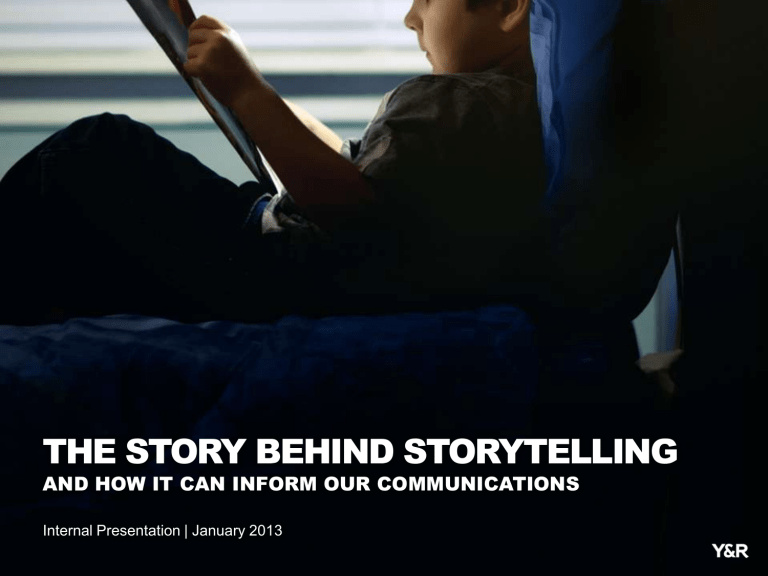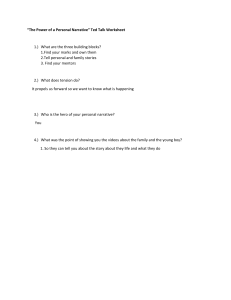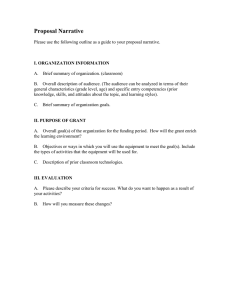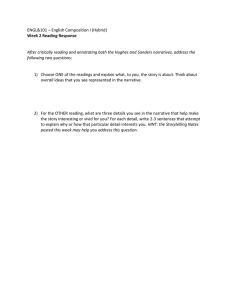
THE STORY BEHIND STORYTELLING
AND HOW IT CAN INFORM OUR COMMUNICATIONS
Internal Presentation | January 2013
ALMOST ANYTHING CAN BE A STORY
BUT NOT EVERYTHING
IS A GOOD STORY
Badlands (1973)
A GOOD STORY HAS ONE OF TWO THINGS
1
IT EITHER
PAINTS THE
PICTURE IN A
COMPELLING
WAY
Tree of Life (2011)
2
OR IT DRAGS
YOU INTO A
COMPELLING
NARRATIVE
Argo (2012)
A REALLY
GREAT STORY
DOES BOTH
The Deer Hunter (1978)
THERE’S A SCIENCE TO IT.
There’s a scientific reason why these two elements
make for good storytelling…
PowerPoint presentations
with bullet points only activate
the language-processing
parts of our brain.
Bullet points only activate two little bullet points in your brain. That’s it.
BROCA’S AREA
WERNICKE’S AREA
But when we are told a good story…
When we are told a good story, our whole brain lights
up. It’s our imagination at work.
#Eureka!
“ THE READING
PROCESS IS AN
INTERACTION
BETWEEN THE
TEXT AND THE
READER’S
IMAGINATION.”
Wolfgang Iser was one of the first reader-response theorists, and he
argued that our imaginations work on two levels:
1. On the level of the sentence: we imagine the events that are
taking place currently in the text (e.g. on page 20)
2. On the level of the narrative: we imagine how the story will
proceed and anticipate how it will end (e.g. what will happen
next and who might die, etc.)
Turns out he was right.
OUR BRAINS CAN RELIVE THE
STORIES WE HEAR…
In terms of brain activity there is very little difference between
experiencing something in real life, reading about it in a book, and
hearing about it in a story.
So…
When we hear “that blueberry pie was delicious” in the context of a
story, our sensory cortex lights up. When we read “John caught the
baseball” in the context of a story, our motor cortex lights up.
Stories are able to activate our imagination on the level of the sentence.
This is why painting a good picture is important.
AND THEY RESPOND TO
LARGER NARRATIVES AS WELL…
But stories also activate our imaginations on the level of the narrative. In
his book How the Mind Works, Steven Pinker talks about how our brain
is fascinated with the direction that stories follow. When reading or
listening to a story, we are constantly imagining what characters will do
next, who will die, who will befriend whom.
This is the power of narrative.
Steven Pinker, How the Mind Works (1997)
WE ARE
HARDWIRED
TO RECOGNIZE
NARRATIVES
Why do we like stories so much? Some anthropologists believe that we are actually hardwired to like stories.
For thousands of years, stories were the key to survival. They were a mode of communicating vital information in a compressed form (e.g. information
about predators, prey, enemies, etc.) Better storytellers and listeners stood a better chance of surviving in this famously brutish and nasty world.
Narratives helped people tell and remember stories. Our brains are good at recognizing patterns, and narratives are basically story patterns.
MORE
ENGAGING
STORYTELLING
MAKES CONTENT…
BETTER
FOR
SHARING
WITH
PEOPLE
To recap: good storytelling makes information much better for sharing and remembering.
And it functions on the level of the sentence and narrative.
MORE
MEMORABLE
WE ALWAYS
TALK ABOUT
WHAT MAKES
GOOD TELLING
We almost never talk about what makes a good narrative, or
even what a narrative is in the first place.
WHAT MAKES A GOOD NARRATIVE?
WHAT IS A
NARRATIVE?
First off, what is a narrative? Before we can construct a
good narrative, we need to know what narratives are.
Countless genres
Let’s start with what a narrative is not. A narrative is not the genre to which it belongs. There are countless genres. (Upstairs downstairs, fantasy, film
noir, Robinsonade, coming of age, dystopian cyberpunk, spaghetti western.) They can refer to anything from the story’s setting to its period to its tone
to its obscure literary technique. One story can be associated with multiple genres.
Genre doesn’t dig deep enough. It doesn’t tell you how the narrative is constructed; it tells you how it is dressed. For example, a film noir and
spaghetti western can have the same narratives and characters. They can be constructed in exactly the same way. They can be built with the same
building blocks, but still be dressed differently. This doesn’t make them fundamentally different stories.
A NARRATIVE IS A SHAPE
Let me explain…
VIRTUALLY EVERY
NARRATIVE HAS ONE
THING IN COMMON:
A protagonist who is trying to achieve a goal
What does almost every story have in common? A protagonist. And what is that protagonist
doing? Trying to achieve something.
MUST. KILL.
VOLDEMORT.
This achievement can be self-improvement… the betterment of society… the betterment of
a relationship… getting a haircut… what’s important is that the achievement of this goal
leaves the character, or the world of the story, somehow better off.
JENNAY!
DON’T
DIE!
B
A
B
THE PLOT TRACES
THE PROTAGONIST’S
PROGRESS TOWARD
THAT GOAL.
A
B
A
And the journey can have different shapes
B
How the character gets from point A to point B, though, can vary. It’s never a
perfectly straight, linear path.
Things can go badly at first, then very well. Or they can go badly for almost
the whole story. If we trace these paths in our heads, we start to recognize
certain narrative arcs again and again.
A
THE FOUR ARCHETYPAL NARRATIVE ARCS…
Over the years we’ve gravitated towards four archetypal narrative arcs.
“Hero’s Journey”
“Growing Up”
coming of age, bildungsroman
SUCCESS
SUCCESS
epic, adventure, fantasy
“Hell and Back”
“When it rains, it pours”
comedy, tragedy, horror
SUCCESS
SUCCESS
confessional, memoir
HAVE BEEN AROUND FOR A WHILE…
These narratives have been around for a long time.
EPIC OF GILGAMESH
15TH CENTURY BC
GOETHE’S WILHELM MEISTER’S
APPRENTICESHIP
1795 AD
ST. AUGUSTINE’S CONFESSIONS
SOPHOCLES’ ANTIGONE
397 AD
441 BC
…AND AREN’T GOING ANYWHERE
And we still see them today.
FINDING NEMO
JUNO
THE SANDLOT
BRIDESMAIDS
A BRIEF HISTORY OF NARRATIVES
HERO’S
JOURNEY
ANCIENT SUMERIAN: 15thc BC
Epic of Gilgamesh
ANCIENT GREEK (EPIC): 8th-6thc BC
Homer, Hesiod, Sappho
TRAGEDY +
COMEDY
ANCIENT GREEK (TRAGEDY +
COMEDY): 5th-4th c BC
Aeschylus, Sophocles, Euripides,
Aristophones
HELL AND BACK
MEDIEVAL LITERATURE: 500-1000 AD
Epic poem, Boccaccio, Chaucer, Dante,
Beowulf, Sir Gawain and the Green Knight
NEW CHRISTIAN TEXTS: 1st-4thc AD
New Testament, St. Augustine’s Confessions,
religious autobiographies
DEFOE’S ROBINSON CRUSOE (1719)
EARLY RELIGIOUS: 6th-1st c BC
Confucius, Taoist, Sun Tzu, the Torah
GROWING UP
ELIZABETHAN/JACOBEAN ERA: 15581625 AD
Jonson, Shakespeare, Marlowe, Cervantes
ENLIGHTENMENT: 1700-1800 AD
Voltaire, Rousseau, Goethe, Pope, Swift, de
Sade, Cooper,
ROMANTIC ERA: 1800-1837 AD
Thackeray, Bronte sisters, Dumas, Flaubert,
Byron, Hawthorne, Austen, Scott
POSTMODERN ERA: 1940Sartre, Camus, Beckett, Orwell, Mailer, Miller,
Pinter, Bellow, Achebe, O’Neill, Updike,
Barthelme, Pynchon
MODERNIST ERA: 1901-1940 AD
Kipling, Fitzgerald, Conrad, Joyce,
Hemingway, Forster, Lawrence, T.S. Eliot,
Faulkner, Huxley, Woolf
VICTORIAN ERA: 1837-1901 AD
Dickens, Bronte sisters, Thoreau, Hugo,
Melville, Eliot, Carroll, Hardy, Wilde, James
These narrative arcs developed in different eras, for different reasons.
TODAY
Franzen, Coetze, Allende, McEwan, Mitchell,
Morrison, Roth, Murakami, Zadie Smith,
Banville, Carey
-THE HERO’S JOURNEY developed during the earliest years of
conquest and exploration.
-TRAGEDY and COMEDY became popular in Ancient Greece, during an
age of many gruesome, imperialistic wars.
-HELL AND BACK developed shortly after the advent of Christianity
and the confessional autobiography.
-GROWING UP became popular because of our Enlightenment
obsession with education and self-improvement.
HERO’S JOURNEY
Narrative archetype that can be traced back to the very first
recorded stories: Gilgamesh, The Odyssey, Beowulf. These stories
feature a protagonist who faces a virtually insurmountable goal and
must overcome several obstacles on the way to achieving that goal.
Genres that typically have this narrative structure are: the epic, the
mystery, adventure, fantasy and sometimes the action movie.
Finding Nemo
Protagonist: Nemo
Goal: finding his father
Challenge: jellyfish, dentist’s office,
fishing net
The Lord of the Rings
Protagonist: Frodo
Goal: protecting the ring/ vanquishing
Sauron
Challenge: Nazgul, Watcher in the
Water, orcs, etc.
Kill Bill
Protagonist: The Bride
Goal: killing Bill
Challenge: Bill’s death squad
HELL AND BACK
Narrative archetype that has its roots in early confessional and
autobiographical literature. It follows a character along a two-step
journey: first away from success, then back toward success. (In
early religious texts, this was seen as a wandering away from God
and pilgrimage back to God.) It is frequently used to tell stories of
survival and self-discovery. Genres associated with this type of
narrative are: autobiography, memoir, war story and travelogue.
Juno
Protagonist: Juno MacGuff
Goal: self-discovery
Challenge: her pregnancy/society
127 Hours
Protagonist: Aron Ralston
Goal: survival
Challenge: the boulder on his arm
Saving Private Ryan
Protagonist: Captain John Miller
Goal: saving Private Ryan
Challenge: WWII
GROWING UP
The coming-of-age story is an enduring narrative that speaks to our
potential for growth and improvement. It usually follows a younger
person as he or she matures in some way. This maturity can be
educational, emotional, financial or even artistic. Because the maturation
and self-discovery processes are internal (inside the protagonist’s head),
she is not always aware of her progress. Genres associated with this
type of narrative are: bildungsroman, early American rags-to-riches,
western and even the modern high-school drama.
The Sandlot
Protagonist: Scotty Smalls
Goal: gaining acceptance among friends
Challenge: new kid in town
Almost Famous
Protagonist: William Miller
Goal: becoming a respected music writer
Challenge: only teenager in the group
My Girl
Protagonist: Vada Sultenfuss
Goal: coming to terms w/ her mother’s death
Challenge: her father, adolescence, TJ’s death
WHEN IT RAINS IT POURS
Narrative archetype on which many comedies and tragedies are
based. At the beginning of the story, our protagonist is going about life
as usual. If anything, life is good (he finds a stash of money, she finds
out she’s the maid of honor). As the story progresses, however, the
protagonist faces a series of challenges, one harder than the other,
almost to the point where she loses hope and gives up. In the case of
tragedy, things often end badly (with everyone dying). In the case of
comedy, there is usually a happy ending that restores normalcy in the
world. Genres associated with this type of narrative are: comedy,
tragedy, horror and thriller (in all their various forms).
Bridesmaids
Protagonist: Annie Walker
Goal: doing something successfully
Challenge: Helen, Todd, financial
constraints
Halloween
Protagonist: Laurie Strode
Goal: surviving the night
Challenge: Michael Myers
No Country for Old Men
Protagonist: Llewelyn Moss
Goal: running off with the money he found
Challenge: Anton Chiqurh and gangsters
MANY KINDS OF PLOTS CAN BE
CONSTRUCTED FROM THESE ARCHETYPES
HERO’S
JOURNEY
HELL
AND BACK
GROWING UP
WHEN IT RAINS,
IT POURS
Homeward Bound
Revenge Plot
Stranded on a Beach
Escape
Vigilante Justice
Comeback Kid
The Outsider
End of the World
Unlikely Hero
Second Chance
Find Yourself
Survive the Night
Classic Underdog
Unjust Accusation
On the Road
Big Brother
Reclaiming the Throne
Courtroom Drama
Whodunit?
Disaster
Many kinds of plots can be built on these narrative models. (Plots are the series of events
that make a story. You can have different plots that still follow the same narrative arc.)
A CLOSER LOOK AT PLOT
HERO’S
JOURNEY
HELL
AND BACK
GROWING UP
WHEN IT RAINS,
IT POURS
Homeward Bound
Revenge Plot
Stranded on a Beach
Escape
Vigilante Justice
Comeback Kid
The Outsider
End of the World
Unlikely Hero
Second Chance
Find Yourself
Survive the Night
Classic Underdog
Unjust Accusation
On the Road
Big Brother
Reclaiming the Throne
Courtroom Drama
Whodunit?
Disaster
You’re far away from home, and there
are many obstacles (known and
unknown) in your way. To get home,
you must keep the faith and keep
fighting.
Homeward Bound (1993)
Someone has wronged you, hurt you,
made your life miserable. Sure, you’re
down… but you’re not out. The story
isn’t over until you get your retribution.
Gladiator (2000)
You’re shipwrecked, deserted, all alone
in a faraway place. To survive and return
home, you must build a temporary
shelter and learn basic life skills.
Cast Away (2000)
Maybe you’ve done something wrong,
or maybe you haven’t… what matters is
that 500 government droids are chasing
you and you must get away.
Minority Report (2002)
A CLOSER LOOK AT PLOT
HERO’S
JOURNEY
HELL
AND BACK
GROWING UP
WHEN IT RAINS,
IT POURS
Homeward Bound
Revenge Plot
Stranded on a Beach
Escape
Vigilante Justice
Comeback Kid
The Outsider
End of the World
Unlikely Hero
Second Chance
Find Yourself
Survive the Night
Classic Underdog
Unjust Accusation
On the Road
Big Brother
Reclaiming the Throne
Courtroom Drama
Whodunit?
Disaster
There are bad guys on the loose, and
you (yes, you!) need to step up and
restore peace in the world. To get to the
boss, you must go through a number of
smaller foes.
Batman (2001)
You’re down but you’re not out. You’ve
suffered a harsh loss, but there’s still a
glimmer of hope. You must believe in
the dream and fight hard to get back in
shape.
Rocky II (1979)
You’re not one of the cool kids. People
are skeptical and resentful of you. To
establish yourself in this world, you
must assert yourself and show your
worth.
Never Been Kissed (1999)
A huge tidal wave is coming. Martians
are circling the White House. You need
to survive this event and help those
around you survive.
Independence Day (1996)
A CLOSER LOOK AT PLOT
HERO’S
JOURNEY
HELL
AND BACK
GROWING UP
WHEN IT RAINS,
IT POURS
Homeward Bound
Revenge Plot
Stranded on a Beach
Escape
Vigilante Justice
Comeback Kid
The Outsider
End of the World
Unlikely Hero
Second Chance
Find Yourself
Survive the Night
Classic Underdog
Unjust Accusation
On the Road
Big Brother
Reclaiming the Throne
Courtroom Drama
Whodunit?
Disaster
You’re not a typical hero type (strong,
confident, determined), but you’ve
been thrust into the role. Now only you
can save the world and set things right.
The Lord of the Rings (2001)
You’ve messed up, and you’re
miserable. But you’re determined to set
things right. To make amends, you must
re-earn the trust of those closest to you
and show them what you’re worth.
High Fidelity (2000)
You’ve lost your way and you don’t even
know it. You’re conceited, pretentious, or
maybe you mistreat the people around
you. To become a better person, you first
need to find yourself and acknowledge
flaws.
Groundhog Day (1993)
A killer is on the loose, hiding in the
shadows. People are dropping left
and right. Your goal is to look out for
yourself. Avoid the killer and come
out on the other side.
Friday the 13th (1980)
A CLOSER LOOK AT PLOT
HERO’S
JOURNEY
HELL
AND BACK
GROWING UP
WHEN IT RAINS,
IT POURS
Homeward Bound
Revenge Plot
Stranded on a Beach
Escape
Vigilante Justice
Comeback Kid
The Outsider
End of the World
Unlikely Hero
Second Chance
Find Yourself
Survive the Night
Classic Underdog
Unjust Accusation
On the Road
Big Brother
Reclaiming the Throne
Courtroom Drama
Whodunit?
Disaster
One moment you’re a fairly well liked
member of society; the next moment
you’re a pariah (deservedly or not). You
must swing the scales of public opinion
in your favor and show people who you
really are.
You lacking something in your life, you
have an urge to explore the world.
Whatever it is, you take to the road and
drive off into the sunset. Along the road,
you meet new friends, see new places,
and meditate on the meaning of life.
It’s sometime in the future. You’re living
in a fascist, totalitarian state run by
sophisticated computers. Computers
that can track your every move. It’s your
job to overturn this government and
destroy the computers.
Mean Girls (2004)
On the Road (2012)
1984 (1984)
David vs. Goliath. Rocky vs. Drago. It’s
an age old premise. You don’t have all
the skills or might, but you’re able to
defeat a stronger opponent due to
sheer intelligence or will power.
The Fighter (2010)
A CLOSER LOOK AT PLOT
HERO’S
JOURNEY
HELL
AND BACK
GROWING UP
WHEN IT RAINS,
IT POURS
Homeward Bound
Revenge Plot
Stranded on a Beach
Escape
Vigilante Justice
Comeback Kid
The Outsider
End of the World
Unlikely Hero
Second Chance
Find Yourself
Survive the Night
Classic Underdog
Unjust Accusation
On the Road
Big Brother
Reclaiming the Throne
Courtroom Drama
Whodunit?
Disaster
You were the king that everybody loved.
But now you’re hiding in a dark cellar,
powerless. For the sake of the crown,
your legacy, and your people, you must
take back the throne.
Star Wars I (1977)
You’ve been charged with first degree
murder, you’re awaiting trial in a
holding cell, but you didn’t do it. To get
a not guilty verdict, you must convince a
jury of your peers that the evidence
against you doesn’t hold water.
A Few Good Men (2000)
A man is dead. His wife is missing. And
his mistress isn’t talking. It’s a mystery,
and it’s your job to figure out what
happened. Little by little, you’re going
to find clues and get to the facts.
National Treasure (2004)
It’s not quite the end of the world, but
it’s dangerous nonetheless. Tornado,
plane crash, sinking boat… to survive
you need to have your wits about you
and luck on your side.
Titanic (1997)
YOU CAN ALSO COMBINE AND MASH-UP
THESE STORYTELLING ELEMENTS.
“Comeback Kid” boxing story (Rocky II)
“Escape” story (Minority Report)
downward-spiraling “when it rains it
pours” narrative
upward-trending, adolescent “growing up”
narrative
+
+
Million Dollar Baby (2004)
The goal is not necessarily to choose a narrative and plot combination that is conventional.
It’s to play around with these narrative and plot combinations.
Some of the most interesting, experimental stories mix and mash-up these
storytelling elements. That’s what makes them innovative.
Moonrise Kingdom (2012)
AN ENDLESS ARRAY OF STORIES CAN BE
CONSTRUCTED FROM THESE ARCHETYPES
Narrative
HERO’S
JOURNEY
HELL
AND BACK
GROWING UP
WHEN IT RAINS,
IT POURS
Homeward Bound
Revenge Plot
Stranded on a Beach
Escape
Vigilante Justice
Comeback Kid
The Outsider
End of the World
Unlikely Hero
Second Chance
Find Yourself
Survive the Night
Classic Underdog
Unjust Accusation
On the Road
Big Brother
Reclaiming the Throne
Courtroom Drama
Whodunit?
Disaster
Common Plots
Setting
Period
Tone
Narratives aren’t just theoretical. The author must construct them from the ground up, with a number of
different storytelling tools. Keeping with film as an example medium, these tools are…
THE SCRIPT
(Blocking out the plot points)
Almost Famous (2000)
SET DESIGN
(Privileged, sheltered life)
CASTING
(He’s just a boy)
Almost Famous (2000)
WARDROBE
(He’s all grown up!)
Almost Famous (2000)
IT’S NOT ABOUT FOLLOWING A MODEL
This is a storytelling model I encountered last year in a similar
presentation. His argument was that all stories have the Hero’s
Journey structure, and that we need to craft all of our stories this
way. (False. Wrong.)
The takeaway: storytelling isn’t about following a strict model.
It’s about understanding the narrative tools at your disposal
and using them.
IT’S ABOUT BEING CREATIVE WITH THE
INGREDIENTS IN FRONT OF YOU
THESE
NARRATIVES
HAVE INFORMED
ADVERTISING
FOR YEARS…
HELL AND
BACK
GROWING UP
Imported from Detroit
Frank Reardon Can’t Use Kayak
Places us In the middle of a “Hell and Back” narrative.
References “Coming of Age” conventions to tell the story of why
Kayak.com was founded. The story of Kayak starts years after
the story of Frank ended.
WHEN IT RAINS IT POURS
HELL AND
BACK
Don’t Have a Grandson with a Dog Collar
Replay
Series of comedic spots that spiral downward quickly, dramatizing what
can happen to you when you don’t have DirecTV. There is no hope from
the very beginning, just (funny) misery.
Turns fifteen years of disappointment and unfinished business into
a two-part “Hell and Back” narrative. By organizing a rematch, two
teams create an opportunity to redeem themselves.
HELL AND
BACK
GROWING UP
Back to the Start
Walk Around the World
2-minute branded entertainment that tells the Hell-and-Back story of
America’s farm industry.
Tells the coming-of-age story of Johnnie Walker, his rise from
local farm boy to respected businessman. This story gives depth
to the brand and informs everything that they do.
GROWING UP
HERO’S JOURNEY
NIKE+ FUELBAND
Small Business Saturday
Nike+ FUELBAND gives you the ability to write your own story of selfimprovement in real time. It tracks your movement throughout the day
and charts your incremental progress. Perhaps this narrativization of
your life will help motivate you to achieve your goal.
A once-a-year event, a nationwide movement. Though not an ad
per se, this project rallies people and businesses against the big
bad corporations that dominate the holiday buying season.
GROWING UP
HELL AND BACK
Kenny Powers MFCEO
The Taste of Coolness
Viral campaign announcing the new CEO-ship of comic
“sportsman” Kenny Powers. Step by step, he transforms K
Swiss from a standard, corporate shoemaker into a loud and
boisterous sports company.
A lagging Romanian chocolate brand fakes an American takeover,
complete with heavy-handed propagandist advertising. The
enemy has come ashore, and it’s up to Romanians to fight back.
HELL AND BACK
WHEN IT RAINS IT POURS
Braddock, PA
Getaway Stockholm
Levi’s didn’t just make an ad about a recovering town, they donated
money and resources to help it recover. They invested in shaping
the second half of the archetypal “Hell and Back” narrative.
Games can have narratives too. This game puts you in the middle
of a Bourne Identity-style “escape” story. It’s capture the flag, and
the last person with the car wins.
HERO’S JOURNEY
GROWING UP
The Girl Who Could Fly
Raise Our Flag
A precocious, intrepid fifth-grader wants to make a video of
herself flying for class. The process is a lot of work, but it all
comes together in the end.
Fundraising campaign for the US Olympic Committee. Every
donation buys a stitch that goes into the American flag. The flag
is a representation of all the hard work that went into preparing
our athletes for competition.
GROWING UP
WHEN IT RAINS IT POURS
SCREW*D
7th Wheel
Interactive reality show about a hapless, helpless, non-DIY guy who
is placed in various uncomfortable situations… from which he must
use his Craftsmen tools to escape.
Three couples (and Matt) head out on a lovely weekend getaway.
They go to the beach; they go canoeing; and they go sightseeing
– and Matt has to suffer through the whole thing on his own.
…EVEN WHEN THE STORIES
AREN’T TOLD IN FULL
Big Brother
Apple: 1984
Doesn’t set Apple on a Hero’s
Journey, it lands the final blow. It
launches Apple into a new
post-dystopian world.
When you only have :30 or :60 seconds to work with, it’s hard to tell a
whole story from start to finish. But it’s easier to tell a scene in
that story. The rest of the story is implied. If you don’t have time
to tell the fully story, it’s worth thinking about how you can tell a
scene and imply the rest of the story.
Step 1
Select your character (e.g. a precocious fifth-grader,
an average Joe, your brand)
Step 2
Decide what her goal is (e.g. learning how to fly,
becoming president, solving global warming)
Step 3
List out the obstacles in her way (e.g. the skeptics
and nonbelievers, blue-collar upbringing, a corrupt
government)
Step 4
Step 5
Decide what narrative arc best tells the story of her
progress (e.g. Hero’s Journey, Hell and Back,
Growing Up, When it Rains it Pours)
Write the story accordingly, bringing out plot points to
shape the narrative and mark its inflection points (e.g.
green screen, recess, Eliza Jones)
SUCCESS
STORYTELLING EXERCISE #1
“Hero’s Journey”
epic, adventure, fantasy
Step 1
List out the potential characters and stakeholders
connected to your brand (e.g. your employees, your
heroes, your customers)
Step 2
Decide what their respective goals are (e.g. learning
new skills, traveling outside the city more often,
feeling a sense of national pride)
Step 3
Map out all the obstacles in their way (e.g. stifling
bureaucracy, lack of adventurous friends, the global
recession and austerity measures)
Step 4
Step 5
Try writing their “ideal” story a few different ways (e.g.
Hero’s Journey, Hell and Back, Growing Up, When it
Rains it Pours)
Brainstorm ways to help them or encourage them to
overcome these obstacles (e.g. a mobile game, an
online forum, a Washington protest, a fake American
takeover of the brand)
SUCCESS
STORYTELLING EXERCISE #2
“Hell and Back”
confessional, memoir
THE END
(AND A NEW BEGINNING)




